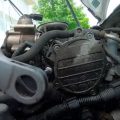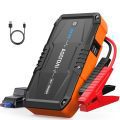This guide provides a comprehensive step-by-step process for converting direct current (DC) to alternating current (AC) using a power inverter. It outlines the necessary preparations, including selecting the right inverter for your needs, connecting the DC power source (such as a battery) to the inverter, and then plugging in your AC devices. Additionally, it emphasizes safety precautions to take while operating the inverter to prevent damage and ensure efficient performance. By following these steps, you will be equipped to power your household appliances and electronic devices with ease.



Gather Necessary Equipment
Gather all the necessary equipment before starting your project. Begin by selecting a power inverter that matches the specifications of your DC source. Ensure the inverter can handle the wattage required by your AC load. For example, if you plan to power a device that uses 300 watts, choose an inverter rated for at least that amount, ideally with some extra capacity for safety. Look for models that provide features like overload protection and short-circuit prevention to safeguard your devices during operation.
Acquire a suitable DC power source, such as a car battery. A fully charged car battery typically provides 12 volts of DC power and can supply a substantial amount of current. Make sure the battery is in good condition and capable of holding a charge to avoid interruptions. Next, procure appropriate cables that can connect the inverter to both the DC source and the AC load. Use cables that are adequately sized to handle the current without overheating; for instance, 10-gauge cables are often suitable for moderate loads. Finally, ensure you have any necessary connectors or adapters that might be needed to make secure connections between all components.


Connect the Power Inverter to the DC Source
Carefully inspect the inverter’s input cables before connecting them to the DC power source. Identify the positive and negative terminals on both the inverter and the power source. The positive terminal is usually marked with a “+” sign and may be colored red, while the negative terminal is marked with a “-” sign, often colored black. Ensure that the cables are free from any damage or frays, as this could lead to potential hazards.
Connect the positive cable from the inverter to the positive terminal on the DC power source first. Secure the connection firmly to prevent any loosening during operation. Next, attach the negative cable from the inverter to the negative terminal on the power source, ensuring a tight fit. Double-check your connections to confirm that they are correctly matched: positive to positive and negative to negative. Avoid reversing the connections, as this can cause irreversible damage to both the inverter and the power source.
Plug in Your AC Devices
Connect your AC devices by plugging them into the inverter’s output sockets. Ensure that the inverter is powered on and check that the DC source, such as a battery or solar panel, is properly supplying power. Before plugging in your devices, verify the total wattage of the devices you intend to use. Calculate the combined wattage to confirm it does not exceed the inverter’s power rating, which is typically marked on the inverter itself. This step is crucial, as exceeding the limit may lead to overheating and potential damage to the inverter or your devices.
Monitor the inverter while it is in use. Keep an eye on the indicator lights or display panel, if available, to ensure everything is functioning correctly. If the inverter has a built-in overload protection feature, it may automatically shut off if you attempt to exceed the power rating. If you notice any unusual sounds, smells, or overheating, unplug your devices immediately and turn off the inverter. Review the user manual for specific troubleshooting tips or guidelines regarding safe usage. Always prioritize safety by checking connections and ensuring that devices are compatible with the inverter.
Turn On the Power Inverter
Switch on the power inverter by locating the main power switch, typically found on the front or side of the unit. Follow the manufacturer’s instructions regarding the specific switch position to ensure proper activation. If the inverter features a remote control, ensure it is connected and functioning correctly before proceeding. Once the switch is engaged, listen for any audible signals or sounds that indicate the inverter is powering up.
Observe the indicator light on the power inverter after switching it on. Most inverters are equipped with a light that changes color or illuminates to signal operational status. A green light usually means the inverter is functioning correctly, while a red or flashing light often indicates a fault or issue that needs attention. If the indicator light does not display as expected, consult the user manual for troubleshooting steps or check connections and settings to ensure everything is set up properly.
Monitor the System
Monitor the inverter’s performance actively while it is in use. Observe the display panel for any warning signs or error codes that may indicate a malfunction. Pay attention to the output voltage and current; fluctuations outside the normal range could suggest underlying issues. Listen for any unusual sounds emanating from the inverter, such as buzzing or grinding, which may indicate mechanical problems. Conduct a visual inspection of the unit to ensure all connections are secure and free from corrosion.
Check for signs of overheating by feeling the surface of the inverter; it should be warm but not excessively hot. If you notice any abnormal heat buildup, immediately turn off the unit and investigate potential causes, such as inadequate ventilation or overloaded circuits. Ensure that your air conditioning devices are functioning correctly, as they should operate smoothly without interruptions when the inverter is working properly. Regularly monitoring these aspects will help maintain the performance of your electrical system.
Key Takeaways and Tips
In conclusion, converting DC to AC using a power inverter is a straightforward process that can empower you to utilize your AC devices with a DC power source. By following the outlined steps—gathering the necessary equipment, ensuring proper connections, and maintaining vigilant monitoring—you can achieve a reliable and efficient power conversion. Whether for home use, camping, or emergency backup, understanding this conversion process broadens your energy options and enhances your ability to harness available power.






I’m curious about any advanced tips for optimizing the setup. Like, can I chain multiple inverters together or is there a limit? Anyone done this?
Thanks for the question! Yes, you can chain inverters, but make sure they are compatible. It’s crucial to follow the manufacturer’s guidelines to avoid any issues. Some advanced setups can indeed improve efficiency!
Pro tip: Always double-check the wattage of your devices before plugging them in. I once tried to power a small fridge and blew a fuse because I didn’t check the specs. Lesson learned!
Great tip! It’s essential to ensure your devices are within the inverter’s capacity to avoid any mishaps. Thanks for sharing your experience!
I had a successful weekend camping trip where I powered my Black+Decker coffee maker using this method. It worked perfectly, and I had fresh coffee every morning! Highly recommend this guide for anyone wanting to enjoy their home comforts outdoors.
Awesome to hear! Nothing beats a good cup of coffee in the great outdoors. Glad the guide helped you out—keep enjoying those camping trips!
Any specific recommendations for inverters? I’m looking at the GoWISE Power PS1004, but I’m not sure if it’s the best option for my needs. What do you guys think?
The GoWISE Power PS1004 is a solid choice! It’s reliable and has a good wattage output for most small appliances. Just make sure it fits your power needs, and you should be good to go!
I adapted your step about connecting the power inverter to suit my RV setup. Instead of hard-wiring, I used a heavy-duty extension cord to connect my Renogy inverter to my battery bank. It made things a lot easier for me while camping!
That’s a clever adaptation! Using an extension cord can definitely make it more versatile, especially in an RV setup where space is limited. Thanks for sharing!
I’ve seen some people use solar panels to power their inverters. Anyone tried that? I’m thinking of going that route for my outdoor movie nights. What do you all think?
Solar panels can be a fantastic addition! They provide a renewable energy source and can keep your inverter powered longer. Just make sure to size your solar setup correctly for your inverter!
This is a great guide! Has anyone tried using a pure sine wave inverter instead of a modified sine wave? I’ve read they’re better for sensitive electronics. What’s the experience out there?